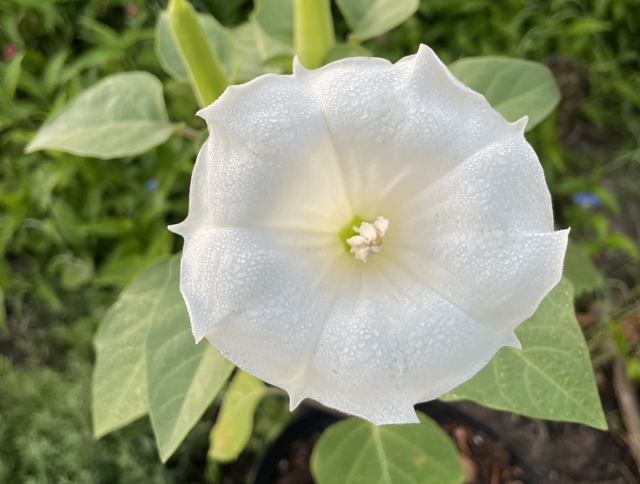
Story and photos by Anita Westervelt. Texas Master Naturalist
The nightshade family of plants includes hundreds of species of showy and fragrant flowers; although dangerously poisonous, they are not without their flamboyant and extraordinary beauty.
There are nearly 2,300 species of nightshade plants worldwide. They belong to the Solanacaea (nightshade) family of plants — most are toxic; the primary toxin is solanine.
Plants, many of you already know, have two types of names, common and scientific. A specific common name may be attached to many different plants; the scientific, or botanical name, is unique to only one plant species.
A case in point, the name angel trumpet belongs to a locally available nonnative tree in the Brugmansia genus of the Solanacea family. The species is native to tropical regions of South America, along the Andes from Venezuela to northern Chile and in south-eastern Brazil; all parts of the plant are poisonous. Brugmansia species are amongst the most toxic of ornamental plants; they contain tropane alkaloids: scopolamine, hyoscyamine and atropine, such as are found in other members of the Solanaceae family.
There’s another plant in the Solanaceae family with the same common name of angel trumpet. It is native closer to home: southwestern United States and northwestern Mexico and east to Texas. Its botanical name is Datura wrightii. It has other common names such as sacred datura, southwestern thorn apple, devil’s trumpet, jimson weed and moonflower.
Datura wrightii has large white trumpet-shaped, upward-facing flowers, sometimes with a tinge of violet at the rim. They open in the evening, are fragrant and rich in nectar and pollinated by moths, typically sphinx and hummingbird moths. The plant is a larval host for the Carolina sphinx moth. Species of bees, hummingbirds and hummingbird moths aid in pollination. The blooms close by the following midday.


The plant is self-supporting but sprawling; it can reach to six feet wide and five feet tall. It is considered a perennial in our zone 10, grows fairly quickly, likes full sun or partial shade, and has a long bloom period.
Datura flowers were a favorite subject of the famous American painter, Georgia O’Keeffe, who lived in New Mexico for many years and painted huge portraits of desert flowers — she was once quoted as saying, “I decided that if I could paint that flower in a huge scale, you could not ignore its beauty.”
Datura wrightii easily propagates via seed; the pods are a pendulous, flat-topped ball about the size of a golf ball. They are pale green and covered in soft spines; pods turn brown when mature; when dry, the fruit splits open at the tip. One seed pod can produce 800 small, flat tan seeds!


The spiky, round pod gives the plant its common designation of thorn apple. The developing pods can easily be snipped off and discarded to prevent aggressive propagation. The plant’s leaves have an unpleasant odor when bruised or crushed. All parts of the plant — from the long, thick tuberous roots to the seeds — are poisonous to humans if ingested although the plant is not known to cause contact dermatitis.
– 30 –

